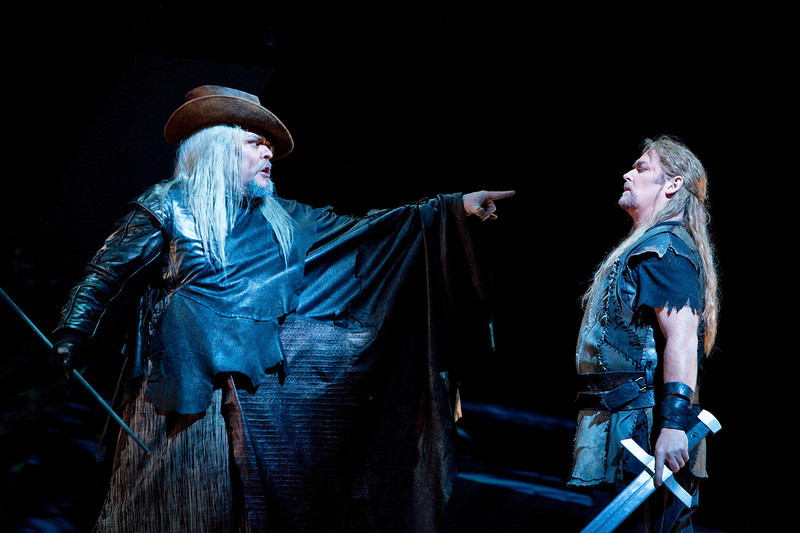
For this #WednesdayWagner ... Some statistics regarding the TOP-10 Wagner Dramas survey you answers in my previous post. Thanks all of you! Let's digest the data
Population of the survey: 64 answers with a list of 10 Wagner Musical drarmas, ordered by preference. This is not exhaustive nor representative, but anyway really interesting (at least, for me)
Average positions are (1=1st pos, 10=10th pos):
- Tristan: 3.0
- Parsifal: 3.0
- Die Walküre: 3.6
- Götterdämmerung: 4.0
- Siegfried: 5.5
- Meistersinger: 6.0
- Rheingold: 6.0
- Lohengrin: 6.7
- Tannhäuser: 6.8
- Die Feen: 8.5
- Holländer: 8.6
- Rienzi: 9.3
- Das Lieverbot: 9.5
- Tristan: 3.0
- Parsifal: 3.0
- Die Walküre: 3.6
- Götterdämmerung: 4.0
- Siegfried: 5.5
- Meistersinger: 6.0
- Rheingold: 6.0
- Lohengrin: 6.7
- Tannhäuser: 6.8
- Die Feen: 8.5
- Holländer: 8.6
- Rienzi: 9.3
- Das Lieverbot: 9.5
Most repeated position (Mode):
- Tristan: 1
- Parsifal: 1
- Die Walküre: 3
- Götterdämmerung: 3
- Siegfried: 5
- Rheingold: 7
- Lohengrin: 7
- Meistersinger: 9
- Tannhäuser: 9
- Holländer: 10
- Rienzi: 10
- Die Feen: no repeated values
- Das Lieverbot: no repeated values
- Tristan: 1
- Parsifal: 1
- Die Walküre: 3
- Götterdämmerung: 3
- Siegfried: 5
- Rheingold: 7
- Lohengrin: 7
- Meistersinger: 9
- Tannhäuser: 9
- Holländer: 10
- Rienzi: 10
- Die Feen: no repeated values
- Das Lieverbot: no repeated values
Interesting plots: Operas chosen as 1st option:. 'Parsifal' and 'Tristan' are by far the most chosen (20 times each) followed by 'Götterdämmerung' (9 times) and 'Die Walküre' (8 times) 
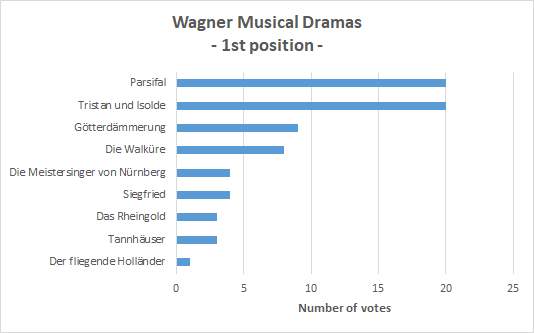
Looking at the operas chosen as 2nd option, we see 'Parsifal' (15 times), 'Tristan' (12 times), 'Die Walküre' (11 times), and then 'Götterdämmerung' and 'Lohengrin' (7 times) 
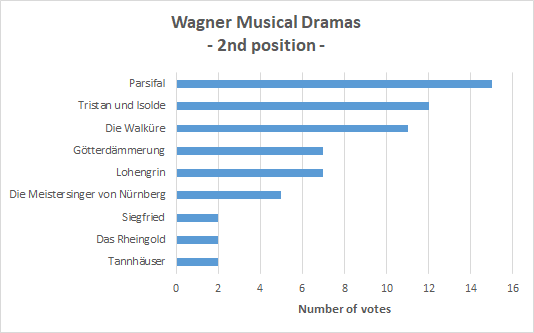
Can we see the evolution of each opera within the different positions, from 1st to 13th? Here we go! At each x-axis position we can see the number of votes of each opera. Really interesting evolution.
PD: Sorry, the colour code is not easy to choose!
PD: Sorry, the colour code is not easy to choose!
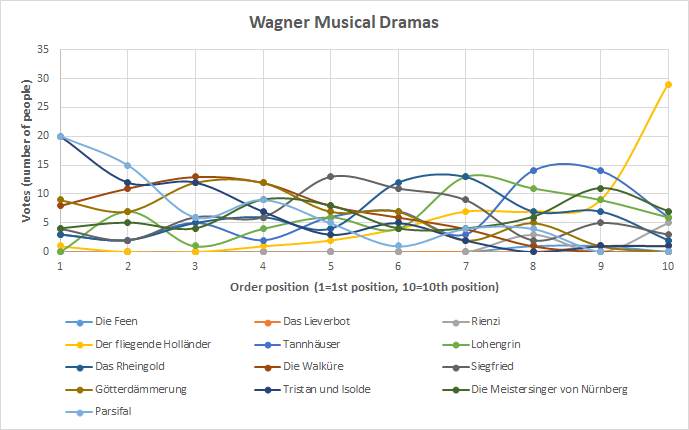
A much more visual plot is the cumulative histogram, i.e., the accumulated votes. If we stop at any position, each opera will show the votes from 1st position up to this one. So we can see how fast/slow each title reaches the maximum number of votes 
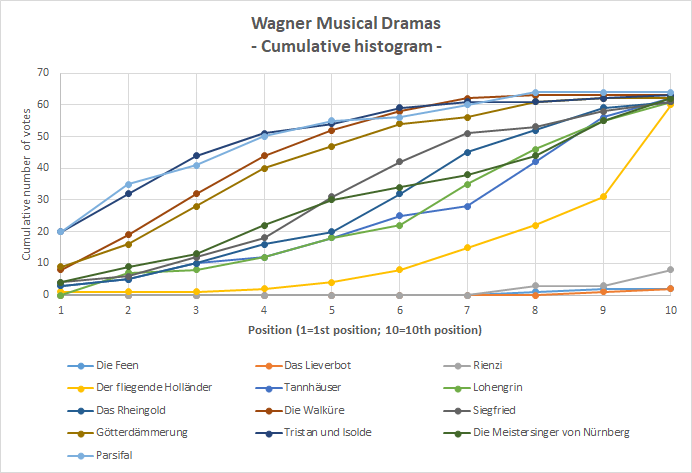
Indeed, we can identify:
- 1st group ('Tete de la course') formed by 'Parsifal' and 'Tristan'
- 2nd group: 'Die Walküre' and 'Götterdämmerung'
- 3rd group: 'Siegfried', 'Rheingold', 'Meistersinger', 'Lohengrin' and 'Tannhäuser'
- 4th group: Holländer
- 5th group: First 3 operas
- 1st group ('Tete de la course') formed by 'Parsifal' and 'Tristan'
- 2nd group: 'Die Walküre' and 'Götterdämmerung'
- 3rd group: 'Siegfried', 'Rheingold', 'Meistersinger', 'Lohengrin' and 'Tannhäuser'
- 4th group: Holländer
- 5th group: First 3 operas
Lastly, let's show the radar plot of each title, to easily see the distribution of votes. The pikes in the shape show those positions with higher number of votes. Here you can see the plots for the first 3 operas (out of Bayreuth canon) 


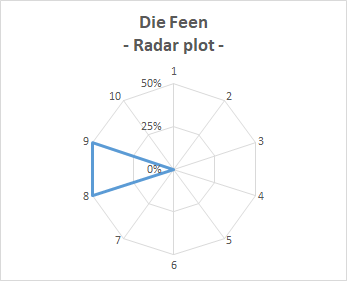

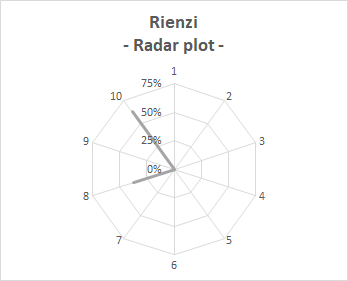
Here there are the plots for the next 3 titles ('Holländer', 'Tannhäuser' and 'Lohengrin'). We can see where the majority of votes are obtained for each title 


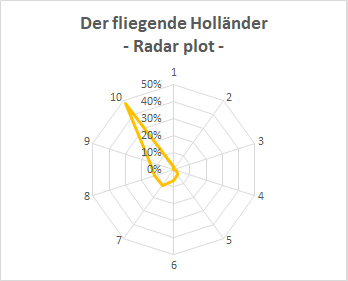
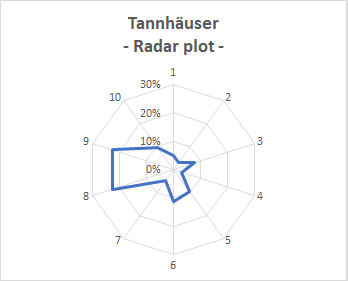
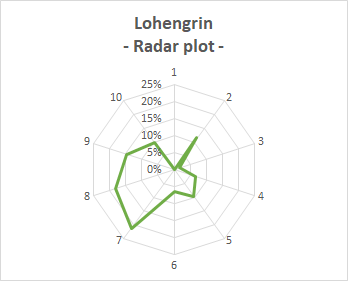
Below you can see the plots for the 'Ring' cycle. Again, we can see that the areas where the votes are obtained are quite constrained 



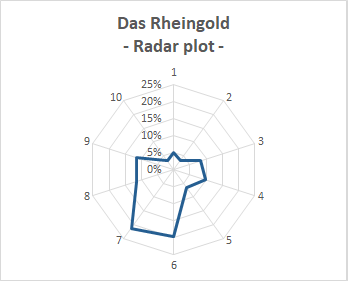
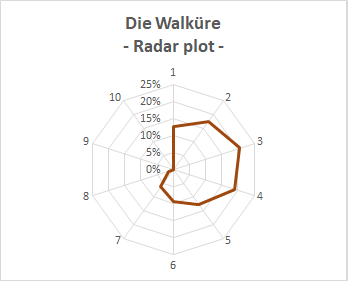
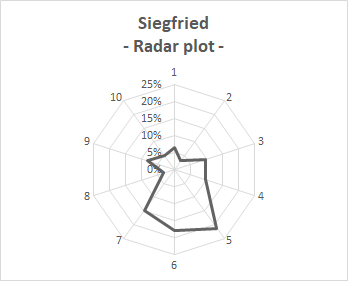
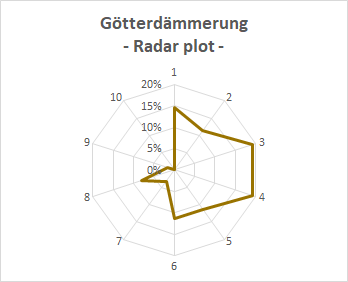
Lastly, the plots for 'Tristan', 'Meistersinger' and 'Parsifal'. We can see that 'Parsifal' and 'Tristan' show clear pikes in high positions, BUT we can see the strange distribution of 'Meistersinger', where opinions are controversial: either 4-5 of 9 positions! 


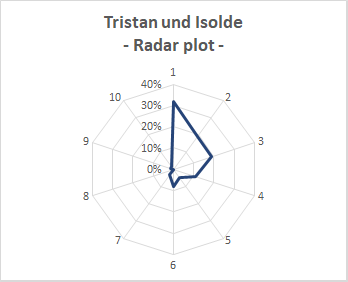
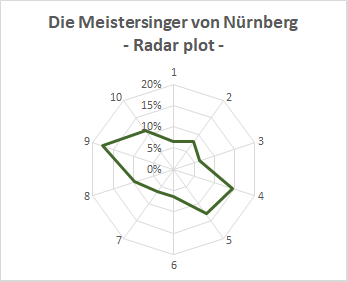
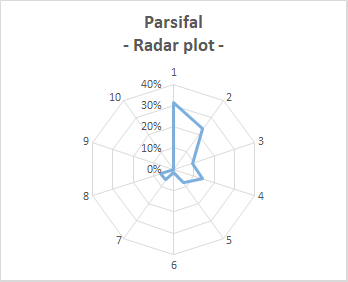
And that is more or less the analysis that can be done. For me, one of the greatest results is not which Wagner opera is more loved or not (all of them are masterpieces), but the split of opinions in 'Die Meistersinger von Nürnberg'.
In any case, 'Parsifal' and 'Tristan und Isolde', closely followed by 'Die Walküre' and 'Götterdammerung', are, by their own merits, clear references in the Wagnerian production. Such a wonderful pieces of art 🙂
@threadreaderapp unroll
• • •
Missing some Tweet in this thread? You can try to
force a refresh





